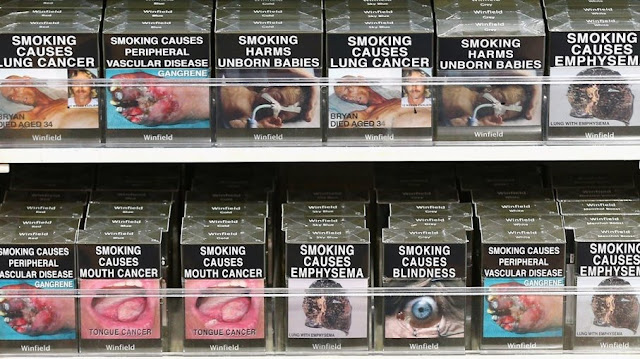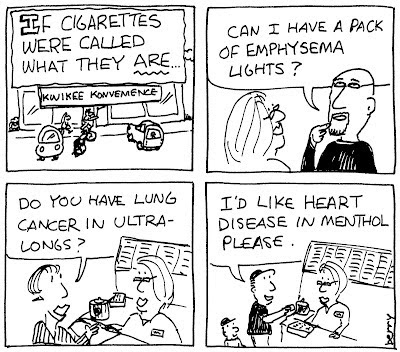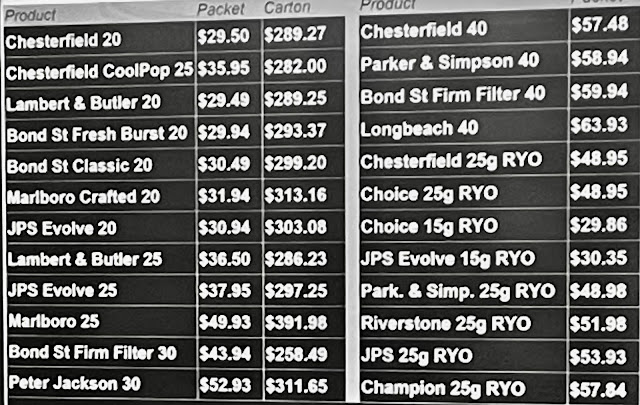Yipes! Just when I thought nothing else here would surprise me, something did!
Australia packages its cigarettes in dark-colored boxes covered with gruesome pictures and horrific warnings about the dangers of smoking.
Each pack highlights specific smoking-related diseases to drive home the message that smoking causes fatal illnesses.
Rheumatoid arthritis, acute leukemia, ectopic pregnancy, kidney cancer, infertility in women, diabetes, erectile dysfunction, blindness, bladder cancer, and peptic ulcers are all diseases that made the cut and appeared on the various boxes.
 |
| Various brands of cigarettes packaged in Australia. |
The objective of the packaging is to force smokers to look at the images and read the health warnings repeatedly.
Each pack is more frightful than the next, but the worst, in my opinion, is the corpse's foot and the warning SMOKING KILLS in large letters.
Wow, I don't see this back home in the US.
 |
| Australia's strategy to make smoking less appealing |
Smoking isn’t illegal in Australia, just demonized by mainstream society and the Australian government.
There are plenty of Aussies who smoke in outdoor spaces and the privacy of their homes.
However, it’s not allowed in enclosed public places in every state and territory in the country.
It is also prohibited n personal vehicles that carry children under 16.
 |
| A smoker with Australia’s plain tobacco packaging with a health warning. AAP Image/Sam Mooy |
Tobacco smoking, which includes cigars, loose-leaf & shisha/waterpipe tobacco products, is responsible for more cancer deaths in Australia than any other single factor.
Smokers have an increased risk of developing heart disease, diabetes, stroke, cancer, renal disease, eye disease, and respiratory illnesses.
But tobacco companies don't talk about the health risks associated with their products.
Cigarette advertising is illegal everywhere except for the ads against smoking plastered on the actual pack.
For years the tobacco industry has taken advantage of this loophole to market their product through their box design, color, and descriptive terminology such as 'low tar,' 'light,' and 'mild.'
Australia's pack advertising has fought back!
 |
| Original Cartoons by Jeff Berry |
Reducing the smoking rate is in the interest of public health, so the Australian government introduced legislation to Parliament that would fight fire with fire.
The controversial Tobacco Plain Packaging Act of 2011 required tobacco products to be in dark-colored packaging with gut-wrenching graphics & actual health warnings.
The legislation passed, and the plain packaging law became law in December 2012.
Today all tobacco products are standardized in Australia, i.e., they all look the same. Very Confusing?
But have they gone too far?
Not for Australia, which is a nanny state by American standards, a term the Brits came up with to describe an overprotective government, especially concerning health and safety.
Some countries will let you do what you want and expect you to do the right (safe) thing. Not here: they pass laws to protect you from yourself.
Australia is a member of the World Health Organization (WHO), an agency of the United Nations that focuses on international public health.
The WHO held a Framework Convention on Tobacco Control (FCTC) in 2003, and Australia became a signatory (co-signer).
They were now accountable for meeting outcomes, including reducing the smoking rate in Australian and Aboriginal communities.
The Plain Packaging Act was one measure Australia took to fulfill its obligation.
Plain packaging doesn't just apply to tobacco products manufactured down-under. Any tobacco company that wants to do business in the Aussie market must comply.
Changing the packaging was a problem for the big tobacco companies, like the Altria Group, Inc., aka Philip Morris International, the biggest cigarette company in the world and the maker of the best-selling cigarette, Marlboro.
They took Australia to court - twice - to argue that plain packaging would diminish the value of the company's trademark.
They lost the first battle in an Australian courtroom and the second in an international arbitration court. The court criticized the case for being an "abuse of rights."
Philip Morris International had to be “hot” to see their logos, bright colors, and expensive package designs exchanged for dark shades, grotesque images, and death warnings.
While the outside of the packages may leave a bad taste in your mouth, the actual cigarettes are the same.
Although, some folks have also complained about the taste.
Tobacco companies deny changing the make-up of their cigarettes.
 |
| Marlboro's packaging stages. |
In US convenience stores, retail merchants showcase their tobacco products on walls behind checkout counters.
These visual display areas are "power walls" because they can draw customers in and entice them to make additional purchases.
"Power walls" draw the attention of children and adults alike, leaving some children to think that because the products are so prominently displayed, they can't be dangerous. Seriously?
In the US, convenience stores below tobacco products are easy to identify, at a glance, by brand or color, and prices are in full view.
 |
| US convenience store cigarette 'power wall.' |
That is not the case in Australia, where tobacco cabinets are as scary as the packs.
The Aussie "power wall' showcases anti-smoking messages and telephone numbers to quitlines. Even at a glance, it is easy to see that the word quit appears twice.
There are no bright colors, familiar logos, or trademarks in view - only a list of cigarette brands for sale and their prices typeset in a medium-sized font.
Not appealing, but you get the message.

Aussie convenience store cigarette 'power wall' - not at all subtle.

According to the World Health Organization, tobacco excise (tax) is the single most effective way to encourage tobacco users to quit.
The Australian government has been raising it by 12.5% each year.
They are already among the most expensive cigarettes globally, and the government's goal is to hike the price up to $52.00 for a 20-pack by 2020.
 |
| Cartoonist John Ditchburn |




Comment box is now open!
ReplyDeleteSis, this is an interesting and informative article!! I hope the governmental endeavor to have people realize their smoking can cause great harm and or death to both themselves, their relatives and others, is effective. Hustler magazine used to show diseased, cancerous lungs next to healthy ones. I stopped for a day once or twice. But to have such graphics each time you light one up, has to have a greater impact on consumption. How much are cigarettes there now? I think the best way to control the use would be to heavily tax tobacco products. I recall stating that I would quit smoking when cigarettes reached .60 cents/pack. Someone once told me, “Just keep smoking. You’ll be straight one day.” I didn’t realize the subtle reference to the coffin.
ReplyDeleteCigarettes here are sold with either 20 - 30 - or 40 in a packed and priced around $1.00 per each cigarette. So, the cheapest brands, not American, start at around $20.00 & up per pack of 20. The American brands are more expensive. Smokers here hate the packs and as a result the smoking rate is down. Many other countries have moved to "plain packaging" as well.
ReplyDelete